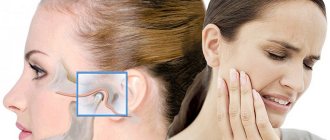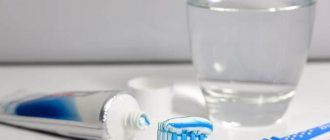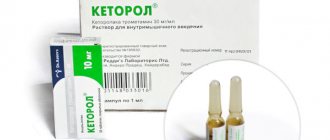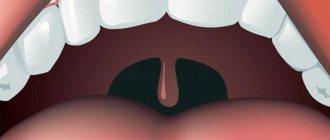Many people face a common problem when their teeth hurt from sweets, it brings great discomfort, because everyone loves to eat a bar of chocolate, candy or drink soda. The human body needs sugar, but for some, consumed sweets are not only a source of discomfort, but also an additional reason for accelerated tooth decay.
Under the influence of carbohydrates, not only the surface enamel layer is damaged, but also the dentin located directly underneath it, then the process of formation of microscopic cracks begins. Small lesions become clogged with pathogenic bacteria that cause the development of caries, so if you experience increased tooth sensitivity, do not neglect a visit to the dentist.
The effect of sugar on enamel
The product itself is not an aggressor and does not destroy surfaces. But when entering the oral cavity along with food, light carbohydrates create favorable conditions for the rapid growth of pathogenic microflora.
Bacteria, feeding on fructose and glucose, actively release waste products, including many aggressive acids. It is they that lead first to a decrease in the thickness of the protective layer, then to the destruction of the enamel and increased tooth sensitivity to sweets.
How do sweets destroy enamel?
Dentin hypersensitivity refers to pain that occurs in response to specific factors that are not caused by another dental problem, such as a chipped or cracked tooth. This can cause tooth pain when eating sweets.
Worn enamel is the main cause of this, which is most common in adults between the ages of 20 and 40.
Dentin hypersensitivity can occur for a variety of reasons, including age-related wear, overly aggressive brushing (at home or professional), receding gums or periodontal disease, and tooth decay. Short-term hypersensitivity also occurs commonly after home or professional whitening. In some people, no specific cause for the condition can be identified. Sweet foods, as well as sour and salty foods, are thought to cause toothache due to short-term chemical effects on soft tissue.
Although sugary products are satisfying, they can damage your teeth by attacking the protective enamel. Sweet foods are usually high in sugar and are one of the causes of sensitivity. Sweets and sugary sodas contain high amounts of carbohydrates, which interact with the bacteria in your mouth. This is capable of producing acids that cause enamel erosion, and thus more sugar leads to increased production and an increased likelihood of sensitivity.
Best materials of the month
- Coronaviruses: SARS-CoV-2 (COVID-19)
- Antibiotics for the prevention and treatment of COVID-19: how effective are they?
- The most common "office" diseases
- Does vodka kill coronavirus?
- How to stay alive on our roads?
Pain and tooth decay is the end result for the enamel, and by the way, when you continue to consume these foods, that same sweet taste can cause pain. If you suspect you are overly sensitive to sugar, there are steps you can take to counteract the effects. To do this, you should consult with specialists. Repeated, constant exposure to sugar can eventually cause teeth to begin to crumble.
Why does sensitivity increase?
Here's what the process looks like step by step:
- acids have a negative effect on the surface;
- the enamel becomes thinner and looser;
- cracks appear into which pathogenic microorganisms and food debris penetrate;
- As bacteria multiply, they move deeper into the tooth, exposing the nerve endings.
As a result of this chain, sensitivity increases and, as a result, hyperesthesia develops. Glucose itself, penetrating through microcracks, irritates the nerve roots in the pulp, causing pain. You can get rid of them only by rinsing your mouth with water, a decoction of herbs, or a special rinse as prescribed by your doctor.
Non-carious lesions
When your teeth hurt from sweets, the cause of the pain may not only be caries. Manifestations occur both with local pathology and with the following deviations from the norm:
- calcium deficiency;
- insufficient intake of vitamins B and D3.
These substances are directly involved in the absorption of glucose. And with existing hypovitaminosis, the body compensates for the lack of useful compounds by leaching calcium from bones and dental tissue, weakening them and increasing destruction. This happens due to poor nutrition, an irrational menu that lacks the necessary substances.
The tooth reacts and begins to ache from sweets, what else could this mean? Discomfort appears as a result of the following problems.
- Incorrect bite, which increases surface friction. This gradually leads to the abrasion of the enamel and its thinning.
- Dentist mistakes during whitening or professional cleaning procedures.
- Attempts to change the color of the dentition at home using either improvised materials or special means without a doctor’s prescription.
- Too frequent use of a hard brush and aggressive cleaning, incorrectly selected toothpaste.
Why does eating sweets make your teeth hurt? Common somatic diseases can also provoke this sensation. Most often it is caused by pathologies of the nervous system, endocrine organs, gastrointestinal tract, and hormonal imbalance.
Significant discomfort appears when there are foods in the daily diet that can damage enamel. This occurs when consuming citrus fruits, pineapples and other fruits, marinades and pickles, and smoked foods, which contain a large amount of acids.
Carious causes
Caries is the most common reason why teeth hurt from sweets and cold. This pathological process exposes the nerve roots located in the pulp and allows glucose and fructose to penetrate inside, causing pain.
Hyperesthesia in this case can be divided into two types.
- Primary is when discomfort occurs at the site of a lesion that has not been treated before. Pain while eating may occur even in the absence of visible damage to the surface.
- Secondary – when the pathological process spreads beyond the previously treated area. In this case, hyperesthesia is detected in the presence of a filling.
Periodontal diseases
If your gums hurt, then you should suspect the development of a disease in this group, especially if a doctor has previously removed the nerves. There are several pathologies.
- Gingivitis is an inflammatory process of the oral mucosa.
- Periodontal disease is a violation of the blood supply, as a result of which the tissues atrophy, settle and expose the neck.
- Periodontitis is a serious disease of the supporting apparatus of the jaw. Deep pockets may form where food becomes trapped.
If a tooth under a crown reacts to sweets, what does this mean and what are the reasons? In this case, problems should be looked for in soft tissues, examining the area where pain occurs. Because under restoration, as a rule, the nerve endings have already been removed by the dentist. We recommend not to delay and consult a doctor as soon as possible and take an x-ray to exclude the development of a pathological process.
Gum pathologies very often cause hyperesthesia. Any inflammation leads to it - be it ulcers on the mucous membrane or serious illnesses, the presence of pockets or receding gums.
Injuries
Toothache from sweets can cause trauma.
- One-time damage to the masticatory apparatus - due to a blow to the jaw or a fall.
- Regular injury may be a consequence of eating too hard foods (for example, nuts, crackers), or having the habit of constantly gnawing something (pencils, nails).
Why do teeth react to sweets?
If your teeth are sensitive to sweets, the first thing to look for is dental pathologies. In 80% of cases, they are the cause of discomfort. The bad news is that if a reaction to sweets is a consequence of an illness, no miracle toothpastes or rinses will help!
Top 5 causes of increased tooth sensitivity
| 1 | Enamel microcracks | Sometimes they can be seen in a regular mirror. But it also happens that microdamages are noticeable only through a binocular loupe or are detected during digital transillumination. Doctors say the main cause of cracks is the habit of gnawing on seeds and nuts, as well as using teeth for purposes other than their intended purpose, such as, for example, opening bottles. |
| 2 | Caries | Sensitivity to sweets will appear already at the stain stage, when visual changes in the enamel are difficult to detect with the naked eye. But large carious cavities located under the gum or in the neck of the tooth also give a reaction to sweets. Sometimes they can only be seen on an x-ray. |
| 3 | Thinning enamel | It develops over more than one month or even one year. As a rule, this is a consequence of many years of dietary mistakes, for example, the abuse of carbonated drinks or the consumption of large quantities of citrus fruits. Sometimes the enamel becomes thinner due to the constant use of pastes with abrasives or the thoughtless use of home teeth whitening methods. |
| 4 | Receding gums | Sometimes it is actually the gums that hurt, and not the tooth, when periodontal disease results in the formation of a kind of pocket as a result of the inflammatory process. And when you eat food, food particles remain between the tooth and gum, which, under the influence of bacteria, quickly turn into acids and begin to eat away at the exposed neck. The causes of receding gums are primarily stomatitis, gingivitis and periodontal disease. But the development of the process can be triggered by:
|
| 5 | Pulpitis | This terrible disease gives the strongest reaction to sweets. Even with a small sip of sweet tea, such patients cannot restrain themselves and cry out in unbearable pain. In addition, it lasts much longer than with hyperesthesia caused by other reasons. And it only subsides at night. |
Remember that grinding sound your teeth make after drinking a glass of Pepsi or Fanta? This is a vivid example of the effect of orthophosphoric acid, which is included in the recipe of almost all refreshing drinks. A couple of glasses a day, and after a few months you will learn from your own example what it is like to have increased sensitivity of tooth enamel.
Unfortunately, it also happens that when you go to the doctor with a problem of tooth sensitivity, no dental problems can be detected during the examination. This is not a reason to give up: you just have to deal with the problem comprehensively: analyze your lifestyle, get examined by specialists, treat chronic ailments.
Indirect causes causing increased sensitivity of enamel
| 6 | Acid reflux | This is a disease in which gastric juice is thrown into the esophagus, and from there it invariably enters the oral cavity. Most often, acid buildup occurs at night, when tooth enamel is especially defenseless against aggressive influences. So, step by step, the enamel becomes thinner, and the patient begins to feel discomfort when eating sweets. |
| 7 | Endocrine disorders, including diabetes mellitus | Hormonal imbalances can directly increase acidity in the mouth. And then the enamel becomes more and more vulnerable to the effects of any irritants. And it can interfere with blood flow and adequate nutrition of tooth and periodontal tissues. |
| 8 | Pregnancy | Hormonal changes in the body of a woman preparing for motherhood are complex and unpredictable. But a year and a half after the birth of the child, everything will return to normal. In the meantime, all that remains is to wait and carefully observe the rules of oral hygiene. The exception is cases of toxicosis. This physiological state is dangerous not only due to dehydration, but also due to insufficient nutrition and, as a consequence, a general decrease in immunity. The body simply ceases to have enough micro- and macroelements to maintain normal gums and tooth enamel. And if you do not seek medical help in time, the consequences will be much more serious than hyperesthesia. |
| 9 | Taking medications | The following side effects include thinning of tooth enamel:
|
| 10 | Avitaminosis | A lack of vitamins primarily affects the condition of the gums. They become inflamed and expose the neck of the tooth. And then everything happens according to the usual scenario: sweets, the work of bacteria and the already familiar pain. |
| 11 | Stress | The mechanism for the appearance of hyperesthesia in this case is slightly different: the body always responds to emotional stress, especially long-term and insoluble ones, by tension in the nerve endings. And those signals that were barely discernible just yesterday, when stressed, respond with a bright painful reaction. |
The mechanism of development of hyperesthesia
With frequent consumption of sugar, the acidity in the oral cavity changes - from alkaline it becomes slightly acidic. A pH shift leads to the destruction of the surface layer of enamel; it is destroyed faster under mechanical stress; a network of small cracks is formed on the teeth, through which food molecules and microorganisms penetrate into the thickness of the dentin.
The mechanism of changes in acidity due to excessive consumption of glucose is associated with the activation of pathogenic bacteria - it is they who secrete acids that destroy the surface during their vital activity.
The thinner the enamel becomes, the more your teeth ache from sweets. As the pathology worsens, negative manifestations begin to arise from eating any food, react to hot, cool temperatures, and even to the air when talking.
The most common symptoms of tooth pain from sweets
Toothache associated with eating sugary foods can be irritating. It occurs due to processes in the internal tissue of the tooth, which can occur for a number of reasons. Common culprits include a cavity, a crack (even a small chip), or a condition called dentin hypersensitivity, among others. The nature and duration of the pain, as well as a dental examination and x-rays, will help your dentist determine the cause of the discomfort and prescribe the best course of action.
Each tooth is covered by a tough outer layer: enamel covers the crown, the visible part of the tooth above the gum; bone tissue (Cementum) covers the roots. Dentin forms the middle layer. This bone-like material encases the soft, innermost part of the tooth, the pulp, which contains blood vessels and nerves. It contains microscopic tubes that extend from its surface via enamel or bone tissue to the inner pulp. Disruption of the enamel or this tissue, affecting the dentin, often results in tooth sensitivity caused by irritation of the nerves in the pulp. It is characterized by sharp pain of short duration that occurs in response to certain factors, including hot and cold foods or drinks, sweet, sour and salty foods, and tapping, touching or drying the teeth.
The main symptoms of sweet sensitivity are:
- It's a dull pain;
- cutting pain;
- tooth pain when inhaling through the mouth (air entering the tooth);
- pain when eating;
- soreness to touch;
- discomfort during routine home cleaning.
Symptoms of sensitivity
At the beginning, hyperesthesia manifests itself as unpleasant sensations upon contact with food and drinks (too warm or cold). Minor discomfort rarely lasts long - it usually goes away on its own after 25-30 seconds, and immediately subsides when rinsed with water.
With severe damage to the enamel, teeth hurt quite a lot from sweets. There may be a feeling of aching, pulsation, or shooting. In some cases, it can be difficult to independently determine which unit is damaged (if there are no visible pathologies). This occurs due to large-scale thinning of the enamel - painful symptoms can spread to neighboring areas, even affecting healthy tissue.
Discomfort tends to occur in waves, weakening over time, creating a feeling of false recovery. But in the absence of adequate treatment, the pain always returns.
Non-systemic reasons
- Exposure to food acids. They are rich in citrus fruits, cabbage of various varieties, radishes, sweet carbonated waters;
- Non-carious lesions of hard dental tissues. Enamel wears off quickly, especially if not properly cared for;
- Development of caries. It provokes erosion of dental tissues or wedge-shaped effects (V-shaped flaw);
- Mechanical tooth destruction. Occurs during strong impacts, bleaching, grinding for subsequent installation of crowns;
- Inflammation of soft dental tissues (pulpitis). The reason is the penetration of infections, mainly bacterial.
Types of hyperesthesia
Depending on the clinic, hypersensitivity can be classified into degrees:
- I – pain during sudden changes in temperature, when eating too hot or cold food;
- II – characterized by the appearance of a teeth reaction to sweet, salty or sour foods, as well as after minor temperature fluctuations;
- Stage III of hyperesthesia is manifested by severe pain, which occurs with any irritant - even with the movement of air during a conversation and touching the affected areas.
Increased sensitivity can be local - appear strictly at one point, or be widespread and affect individual areas of the jaw. In the latter case, the entire dentition is exposed to the disease.
Ways to solve the problem
What to do if your teeth react sharply to the consumption of sweets? The main thing is to limit the intake of confectionery, chocolate, sweets, carbonated drinks and other irritating foods. But you can’t achieve results just by eliminating sugar from your diet; you need to visit a dentist who can identify the problem and offer adequate treatment options.
If a violent reaction of teeth to sweets is caused by a carious process, the problem needs to be solved urgently
There are various methods for this - at the initial stage of caries, it is enough to grind the surface of the molar and apply a special composition to it that stops the destruction process. For moderate and deep cases of the problem, a drill is used, the tooth cavity is cleaned of damaged tissue, and nerve removal is often required (in case of a complication in the form of pulpitis). The molar is then filled with the selected material.
If after filling the problem of sensitivity to sweets is not solved, perhaps the root cause is the thinning of the enamel layer. To get rid of the pathological condition of teeth, there are several ways:
- application of special compounds to the surface of the molars, which will fill microscopic cracks and eliminate increased sensitivity. Such formulations can be long-lasting or those that need to be applied daily (in the form of toothpastes);
- physiotherapy - stimulates the enamel layer to recover on its own and shows good results in eliminating the problem of hypersensitivity;
- the use of toothpastes, rinses and other products designed specifically for sensitive teeth with thin enamel;
- fluoridation of teeth - indicated for patients who live in unfavorable conditions (for example, in areas with insufficient fluoride content in water). The element is introduced into the body gradually, using food products rich in fluoride, specialized pastes and tablet preparations.
In advanced cases, when the filled tooth continues to hurt from sweet foods due to thin enamel, the doctor may recommend a composite restoration. The method involves applying a special composition (composite) to the molars in several layers, each of which is cured using a lamp. In this case, microscopic pores, cracks and chips are filled, and the sensitivity problem is solved for the next 5 years
However, this method also has a drawback - the material filling the surface of the tooth damages the natural enamel layer.
Sensitivity caused by damage to gum tissue is treated by eliminating the existing disease
In the treatment of gingivitis, periodontitis and periodontal disease, there is a general algorithm that includes the following measures:
- Taking antibiotics if a secondary infection occurs after inflammation of the gums.
- Rinsing the mouth with decoctions of medicinal herbs - chamomile, calendula, St. John's wort, oak bark, sage. You can use solutions of Furacilin, Miramistin or Chlorophyllipt.
- Application of antimicrobial and healing pastes to the gums - Cholisal gel, Metrogyl Denta, Asepta and others.
- Physiotherapy.
- Vitamin therapy.
What causes an acute reaction of teeth to sweets and how to solve this problem can be determined by a dentist, so at the first signs of sensitivity you should not delay a visit to the clinic. The sooner the necessary treatment is prescribed, the higher the chances of keeping molars healthy.
Diagnosis of hyperesthesia
If your teeth hurt from sweets, what should you do? It is imperative to conduct a high-quality examination, including in order to exclude serious diseases: pulpitis and periodontitis. This can only be done by a professional - therefore, you should not self-medicate, and if pathological symptoms occur, consult a doctor as soon as possible.
Dentists adhere to a certain algorithm.
- A visual inspection is carried out, during which significant enamel defects and chips may be detected.
- EDI (electroodontodiagnosis) is a research method that monitors the reaction to a directed electric current. Pathology should be suspected if the final value exceeds 2-6 microamps. But this technique only works on living pulp, and is considered not always reliable and already outdated.
- The cold test is a more common test used by dentists. During the study, the surface is exposed to cold or heat, in which the nerve endings react to the stimulus. The dentist evaluates the speed and severity of the reaction. The Freeze test is the most accessible, fastest, convenient and reliable method for determining the disease.
Experts' opinion
The clinical effectiveness of Asepta products has been repeatedly proven by scientific research. For example, as part of a clinical study of the line of products conducted by Doctor of Medical Sciences, Professor A.I. Grudyanov, the high effectiveness of the Asepta mouth rinse for moderate periodontitis was established.
Research conducted at the Kazan State Academy also determined that the use of preparations from the Asepta line (gels, balms, toothpastes, rinses) makes the treatment of chronic catarrhal gingivitis and other inflammations, mild and moderate chronic periodontitis, hyperesthesia of hard dental tissues more effective , which together significantly reduces the duration of treatment and increases the duration of remission in this category of patients.
Sources:
- Study of the clinical effectiveness of treatment and prophylactic agents of the Asepta line in the treatment of inflammatory periodontal diseases (A.I. Grudyanov, I.Yu. Aleksandrovskaya, V.Yu. Korzunina) A.I. GRUDYANOV, Doctor of Medical Sciences, Prof., Head of Department I.Yu. ALEXANDROVSKAYA, Ph.D. V.Yu. KORZUNINA, asp. Department of Periodontology, Central Research Institute of Dentistry and Maxillofacial Surgery, Rosmedtekhnologii, Moscow
- The use of drugs from the Asepta line in the complex treatment of inflammatory periodontal diseases (N.V. Berezina E.N. Silantyeva S.M. Krivonos, Kazan State Medical Academy. Kazan.) N.V. BEREZINA, E.N. SILANTIEVA, S.M. KRIVONOS Kazan State Medical Academy
- Report on the determination/confirmation of the preventive properties of personal oral hygiene products “ASEPTA PLUS” Remineralization doctor-researcher A.A. Leontyev, head Department of Preventive Dentistry, Doctor of Medical Sciences, Professor S.B. Ulitovsky First St. Petersburg State Medical University named after. acad. I.P. Pavlova, Department of Preventive Dentistry
- Clinical studies of antisensitive toothpaste “Asepta Sensitive” (A.A. Leontyev, O.V. Kalinina, S.B. Ulitovsky) A.A. LEONTIEV, dentist O.V. KALININA, dentist S.B. ULITOVSKY, Doctor of Medical Sciences, Prof. Department of Therapeutic Dentistry, St. Petersburg State Medical University named after. acad. I.P. Pavlova
- https://www.youtube.com/watch?v=pkFytNfE0NM
- https://www.youtube.com/watch?v=xRPTq5y9YRQ
Treatment of hyperesthesia
When your teeth hurt after eating sweets, what should you do? The main thing is not to delay going to a specialist. You should not self-medicate, as this can aggravate the situation and lead to the development of complications.
The maximum that can be done before visiting a doctor to reduce pain is to take an anesthetic tablet and rinse your mouth with a rinse marked “for sensitive enamel”, a soda solution or sage decoction.
General treatment strategy
Only a doctor can determine which direction you should follow.
If you are asking the question: “Why do my teeth hurt when I eat sweets?”, then there are several approaches to restore the integrity of the enamel in the presence of microcracks.
- Remineralization.
- Physiotherapy.
- Application of fluoride varnish.
All of these methods are applicable when there is no significant defect. If there is caries, then it is subject to high-quality treatment. If there are problems with the gums, an appropriate therapeutic strategy is selected.
Remineralization
If the surface layer of enamel is partially destroyed, it is recommended to use special gels that contain a complex of minerals (fluorine and calcium).
If your teeth and gums hurt from sweets, but there is no caries, this is the best option to eliminate the problem. With regular application of remineralizing agents to damaged elements, microcracks are eliminated and sensitivity to external irritants is reduced.
Fluoridation
The procedure is carried out in two ways:
- Simple. It can be carried out when the enamel is slightly damaged. The bottom line is that a remineralizing mass is applied to the damaged parts and protective caps are put on top. The mixture is kept for 15 minutes, after which the oral cavity is treated. For more effective treatment, you need to undergo several such procedures.
- Complex fluoridation begins with professional cleaning, after which a special composition is applied intermittently.
What to do if your teeth begin to react to sweets?
If painful sensations arose for the first time, and even after you were carried away by freshly picked raspberries or strawberries, you should not worry too much. Rinse your mouth with clean warm water and try to spare your tooth enamel in the coming days.
But when the situation repeats regularly, there is no point in postponing a visit to the dentist. Perhaps, already at the first appointment, the doctor will detect the problem and draw up a treatment plan. But it is likely that the result of the examination will be a recommendation to consult a periodontist, orthodontist, surgeon, and even a therapist.
Hyperesthesia is one of the most common diseases in the world. Dentists heard complaints about toothache from eating sweets from 37% of their patients. Moreover, the lion's share of them are people of the most productive age: from 20 to 40 years.
Treatment at home
Mild, short-term manifestations of hyperesthesia caused by thinning tooth enamel respond well to home treatment. Moreover, the choice of methods today is very large: from time-tested folk recipes to quick-response pharmacy products.
Traditional methods. Healers recommend relieving acute pain caused by sweet foods with alcohol rinses and a compress in the form of a piece of unsalted lard. To prevent repeated attacks, you should buy purified sea salt at the pharmacy. It should be diluted in the proportion of 1 teaspoon per glass of warm water. And rinse your mouth for 15-20 minutes 3-4 times a day.
A decoction of sage will also help reduce the sensitivity of enamel: 3 tablespoons of dry leaves are poured with a liter of boiling water and boiled for another 10 minutes. Then let it cool and strain. The resulting decoction can simply be periodically applied to the aching tooth, and if the entire dentition is acutely aware of sweets, rinsing will be more effective.
The most unusual folk method that promises to cope with acute toothache caused by sweet foods is acupressure. According to it, you need to press firmly on the nail plate of your index finger for several minutes. Moreover, if the tooth hurts on the right side, you need to press on the finger of your left hand, on the left side - on the right hand.
Hygiene products. In case of severe hyperesthesia, it is worth trying to strengthen the tooth enamel as much as possible. Toothpastes and rinses with fluoride ions will be good helpers in this matter:
- "Lakalut";
- "Sensodyne";
- "Splat";
- "Mexidol dent."
In order not to read into the composition of the product, look for the inscription that the toothpaste is intended for the care of sensitive teeth. Such hygiene products create a protective film on the enamel surface and promote the active absorption of fluoride.
The effectiveness of treatment can be assessed after 2 weeks. If after 14 days of using specialized pastes or rinses there is no effect, the protective layer of enamel is severely damaged. And you can’t do this without the help of a doctor.
Pharmacy drugs. Ideally, they should be recommended by the attending physician. But since the medicines are freely available and do not require special skills to use, thousands of patients use them every day at their own peril and risk.
- “Fluorovarnish”, which forms a dense film on the teeth, thereby reducing the sensitivity of the enamel to external irritants;
- "Remodent", powder for preparing a solution for applications and rinses;
- "Belagel F", restoring the mineral balance of enamel;
- “Diplen”, a film that is temporarily attached to the teeth and saturates the enamel with fluoride compounds.
Like any medications, pharmaceutical drugs for hyperesthesia have side effects and contraindications. Thus, excessive efforts to saturate tooth enamel with fluoride can even lead to such a terrible disease as endemic fluorosis. Therefore, treatment of hyperesthesia at home must be carried out under the supervision of a doctor.
We treat sensitive teeth for 10% cheaper! Sign up!
Moscow
Treatment in dentistry
If a dental pathology is detected when a patient complains about enamel sensitivity to sweets, then the doctor will first treat it:
- will cure caries. Moreover, even if the patient complains of sensitivity of only one tooth, for the purpose of prevention, all carious lesions must be eliminated, and then professional cleaning must be carried out;
- if pulpitis is suspected, an x-ray will be taken, and then a decision will be made: preserve the pulp, remove it partially or completely;
- for periodontal diseases, medication or physiotherapeutic therapy will be prescribed;
If tooth enamel throughout the entire oral cavity is thinning, the dentist may recommend restorative procedures: fluoridation, remineralization, veneers, or enamel implantation.
In the most difficult cases, iontophoresis is used. This is a procedure in which electrodes with a medicinal solution: calcium gluconate or “Fluocal” are applied to the patient’s teeth. Weak electrical discharges allow macroelements to saturate the enamel with the substances necessary for its restoration.
The choice of treatment method for increased tooth sensitivity to sweets directly depends on the cause of the pathology. Only a doctor can determine it, as well as choose the most effective path to recovery.
What can you do at home?
What to do at home when your teeth react to sweets and hurt from chocolate?
- If you experience severe discomfort, you can take a tablet of any painkiller before going to the doctor.
- Use special gels and pastes, rinses that reduce hypersensitivity.
- Traditional methods are usually ineffective, but can temporarily relieve discomfort. These include rinsing the mouth with a decoction of oak bark, sage, and applying tea tree oil to problem areas.
It should be remembered that self-medication is not recommended. This may be a necessary measure while waiting for an appointment with a doctor. It is advisable to carry out all independent manipulations after consultation with a specialist.
Tooth reacts to sweets after filling
The culprit of a strong reaction to sweets may well be the dentist. If caries is treated, but the pain remains, this may be a sign that:
- the carious cavity was poorly cleaned;
- the filling material was used in insufficient quantities;
- The technology for installing the seal itself is broken.
Temporary hyperesthesia after treatment of caries and any surgical interventions in the oral cavity is a normal option. During the treatment process, the doctor uses both abrasive materials and drugs containing strong acids. And the enamel will take some time to fully recover.
But if month after month passes after treatment, and the sensitivity of the filled tooth does not disappear and even intensifies, it’s time to sound the alarm. This is a clear signal that mistakes were made during the treatment process.
Moreover, sometimes even a dead tooth begins to react to sweets, inside of which there is no living nerve left. Patients are surprised: “Where can pain even come from if the pulp is removed and the canal is sealed?” But the tooth is still surrounded by soft tissues in which the nerve endings are preserved. And they also react sharply to the infectious process.
To identify mistakes made by the dentist when removing the nerve, the doctor may recommend an x-ray examination. It will tell you for sure whether the cause of sensitivity to sweets is a partially preserved pulp, or whether the infection should be looked for in the periodontal tissues.
Sensitivity Prevention
To prevent the occurrence of hyperesthesia, it is important to pay due attention to regular hygiene procedures. After finishing meals, rinse your mouth thoroughly.
If your tooth hurts after eating something sweet, you need to undergo systematic preventive examinations at the dentist. If necessary, have it professionally cleaned - this will help avoid the formation of plaque and get rid of the stone.
Clean your teeth with the right toothpaste, containing the entire set of microelements. Choose brushes of medium hardness that do not injure your gums. Carefully remove food debris from between teeth using floss. Use a waterpik regularly.
Prevention
In order not to suffer from severe pain every time while eating sweet foods, you should follow preventive measures:
- brush your teeth after eating food, if this is not possible, use dental floss or mouthwash to remove food residues;
- at night, brush not only the teeth, but also the cheeks, palate and tongue;
- review your diet - introduce foods rich in calcium, vitamin B, fluoride, protein and fiber into the menu;
- limit the amount of sweets consumed, including carbonated drinks;
- get rid of bad habits;
- treat chronic diseases of the gastrointestinal tract, since increased stomach acidity provokes premature destruction of the enamel layer of teeth.
It would be useful to remind you that in order to keep your teeth healthy, you need to visit the dental office regularly.
If a person does not notice caries in his mouth, this does not mean that it is not there - the destruction process can begin at the junction of the molars or even from the inside. Only an experienced doctor can notice any pathological changes, as well as offer the best options for eliminating them.
Of course, almost all people love sweets, but not many people think about the possible consequences of overusing treats. If a person eats chocolate too often, this is fraught not only with increased sensitivity and reaction of the teeth, but also with subsequent damage to the enamel and the development of caries.
Untreated inflammation in the oral cavity, caries and thin enamel are the causes of severe consequences such as periodontitis, periodontal disease, pulpitis and others. If signs of a violent reaction of teeth to sweets appear, you should immediately contact the dentist to avoid unpleasant complications.
Selection of paste for prevention
For hyperesthesia, it is important to choose the appropriate care designed for sensitive enamel. Such products are distinguished not only by more delicate cleansing, but also contain components that promote remineralization and reduce gum inflammation.
What parameters to pay attention to when choosing.
- When your teeth become clogged with sweets, choose products to cleanse your mouth that contain ingredients designed to reduce sensitivity - fluoride, strontium, zinc salts, hydroxyapatite, potassium chloride or nitrate, calcium carbonate and arginine.
- The product should have an abrasiveness no higher than 25-35 RDA (for example, for bleaching options this figure can reach 100-120).
The effect of sweets on teeth
Cookies, candies, chocolate and other confectionery products contain large amounts of carbohydrates - in particular sucrose (sugar). Under the action of salivary enzymes, sucrose is converted into glucose, which immediately begins to oxidize. The process of glucose oxidation is a fermentation reaction, the determining role in which is played by microorganisms (bacteria) that live in the oral cavity. As a result of fermentation, organic acids are formed - lactic, butyric, formic, propionic, etc. The aggressive action of acids leads to the destruction of tooth enamel - it becomes loose and sensitive.
Tooth enamel is the hardest tissue in the human body. It is what protects our teeth from negative influences, irritants and diseases. Healthy enamel makes your teeth look attractive and shiny. The protective and aesthetic properties of enamel are due to the high level of mineralization. It mainly consists of hydroxyapatite, which contains calcium, as well as fluorine, magnesium and carbon. But the problem is that hydroxyapatite crystals are very susceptible to the aggressive effects of acids that are formed as a result of the oxidation of sucrose and fermentation of glucose. As acid levels in the mouth increase, the crystals break down and the enamel weakens.
To protect teeth from the negative influence of external and internal environmental factors, enamel covers their crowns completely. On the chewing apexes, the enamel layer reaches 2.3 - 3.5 mm, on the lateral surfaces it reaches 1.0 - 1.3 mm and completely thins out at the neck of the tooth - the place at the level of the gum edge where the crown meets the root. The crown of the tooth itself consists of dentin, inside of which there is a pulp, penetrated by a large number of small vessels and nerve endings. It is fibrous, loose and characterized by high pain sensitivity to external stimuli. The pulp provides trophism to the tooth tissue and is responsible for transmitting sensory information about its condition to the central nervous system. In case of damage to the enamel of the crown, cervical tissue or root, external irritants through the dentinal tubules affect the pulp, and we feel severe pain. This is a kind of signal indicating that there is something wrong with your teeth and it’s time to see a dentist.
Let's sum it up
Only a qualified doctor will be able to determine the tactics and scope of therapy, so you should not self-medicate. Timely medical intervention will help resolve problems and prevent the development of complications.
If your teeth hurt from sweets or react to heat or cold, then it is important to identify and eliminate the cause as quickly as possible. This may be a banal thinning of the enamel or lesions that require serious therapy. Visit the website dentika.ru and find out everything about modern dental care first-hand.
Treatment in dentistry
After diagnosing the condition of the oral cavity and studying the patient’s medical history, the dentist will determine the exact cause of the pain. Depending on the diagnosis, conservative therapy or surgical intervention will be prescribed. In modern dentistry, the following methods for eliminating pain after sweets have proven themselves well.
- Fluoridation of enamel.
- Remineralizing therapy.
- Sealing of fissures.
- Correction of bite pathologies.
- Preparation of damaged tissues and placement of fillings.
- Installation of crowns, veneers, lumineers.
- Dental implantation.
What to replace unhealthy sweets with
Not all sweets are harmful to the body. Some treats can be beneficial. Dentists advise replacing harmful toffees and caramels with the following products:
- Honey _ It is a natural product rich in glucose and fructose. However, honey also contains a large amount of useful substances, vitamins, amino acids and minerals.
- Nuts . Most nuts combined with honey can replace any candy. Unlike confectionery sweets, nuts saturate the body with protein.
- Berries and fruits . Healthy alternatives to candy include pears, apples, raspberries or cherries.
- Dairy desserts . Natural yogurt with berries or cottage cheese with fruits also have a sweet taste. At the same time, dairy products are rich in vitamins and calcium.
Before you eat another piece of delicacy, you need to remember that it can not only hit your figure, but also harm your smile.
What are the dangers of sweets?
Almost all sweet products: sugar, soda and syrups, jam, confectionery, sweet fruits (bananas, strawberries) are classified as simple carbohydrates. Such foods are broken down very quickly in the body and increase the amount of glucose in the blood, adding energy. This is effective before sports. When energy is not wasted, it is deposited in the form of fat reserves.
To break down and absorb simple carbohydrates, the body needs B vitamins and calcium. Teeth become a source for quickly obtaining the necessary macronutrients.
If the diet does not have enough vitamins and calcium, and a person consumes sweets excessively, then the expended reserves of necessary substances do not have time to be restored. This is how the process of internal tooth decay occurs. During this process, the enamel becomes thinner and caries develops.










